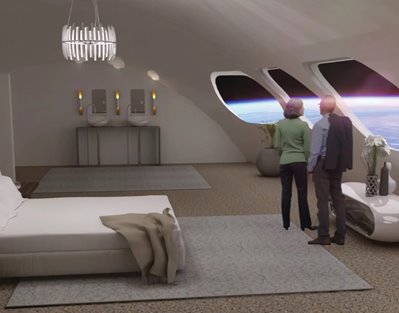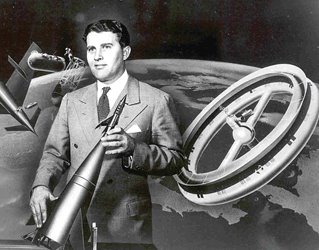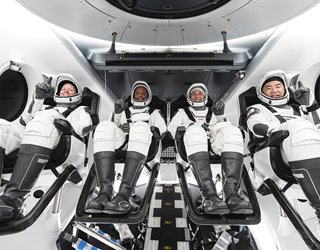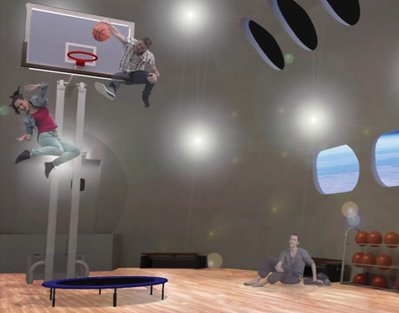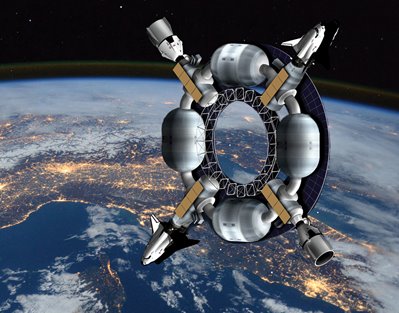Space Station Could Bring Weight to the Weightless
Space Station Could Bring Weight to the Weightless
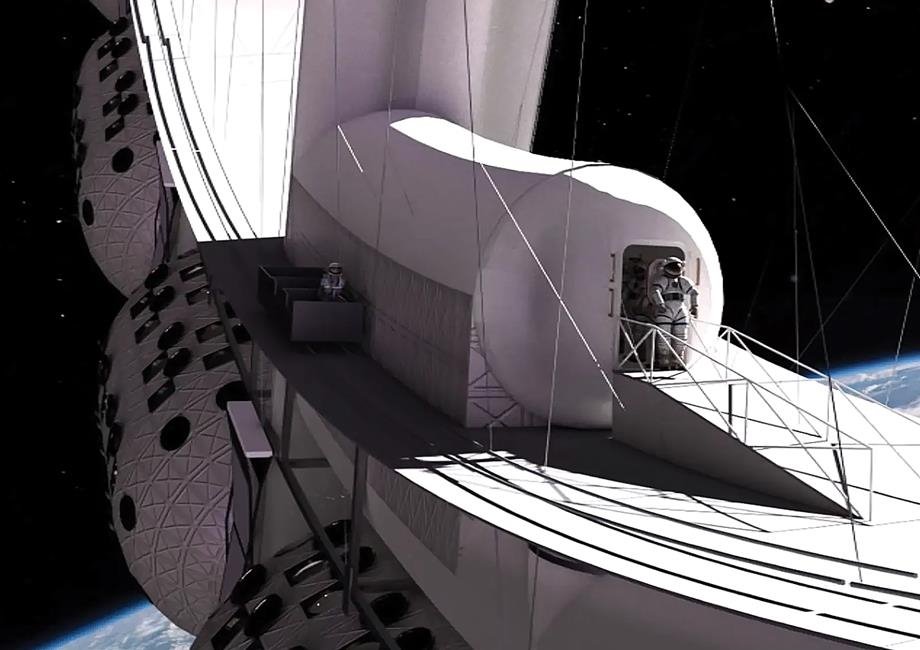

Zero-g conditions can make long-term stays in space unpleasant and even unhealthy. One startup is reviving an old idea to provide astronauts with a sense of up and down.
Some business plans for startup companies are dirt simple. “It’s like Uber, but for lawn mowers.” “Working to be the Netflix of cat food.” The vision of the leadership team at Orbital Assembly Corp., based in Fontana, Calif., is a bit more subtle: It’s sometime in the 2030s and you’re checking in on a small factory at Orbital Assembly’s Voyager Station, in low Earth orbit. After the thrill of the launch and the glide to the station, the shuttle you are on docks, the air lock opens, and you enter the station. In the docking area, you float weightlessly as did generations of astronauts before you.
Take the elevator down to the main part of the station, however, and a familiar sensation takes hold—weight. It’s not the full weight that you are used to back home, so you feel light and bouncy. You can leap over chairs and literally bounce off the walls.
Even so, to hear Orbital Assembly tell it, that bit of pull “down” is the key to successful and enjoyable living in space. The human body doesn’t do well in weightlessness, especially for long periods of time. Provide some semblance of gravity, even artificially, and people can be healthier, happier, and more productive.
Humans have been staying in space stations since the 1970s, with the Soviet Union’s Salyut and the American Skylab. Astronauts and cosmonauts have been occupying the International Space Station since 2000. But over all those orbits, every visitor from Earth has had to confront the discomfort and sheer inconvenience of weightlessness. Activities that we do without a second thought—from eating and drinking to voiding and sleeping—all become multistep functions to keep debris and astronauts from careering around the cabin.
With the planned decommissioning of the International Space Station scheduled for later this decade, there is a rush of companies drawing up plans for commercial space stations to replace it. None are as ambitious as Voyager, which as envisioned would be 200 meters across and have room for 400 visitors in 24 circumferential modules.
Orbital Assembly has designed a four-module version, called Pioneer Station, as a first step that could be in orbit as soon as 2027.
The form of the Voyager and Pioneer is instantly recognizable to anyone familiar with the history of human space exploration. These stations would be wheels rotating a few times a minute. Occupants on the interior surface of the torus would experience centripetal acceleration that will mimic, to a certain extent, how gravity feels on Earth. Because that acceleration is a function of both the rotational speed and the distance from the center of the torus, the center would still feature weightlessness.
“You have to go from the center out to the rim that’s rotating fast enough to give significant artificial gravity,” said Tom Spilker, co-founder of Orbital Assembly Corp. and a former scientist and engineer at NASA’s Jet Propulsion Laboratory, where he spent over 20 years sending vessels into space. “And once you are in that artificial gravity system, it will be much more similar to being on Earth. And yet it will be obviously not on Earth.”
The idea of mimicking gravity using the centripetal acceleration of a rotating torus is old—so old, in fact, that it predates Robert Goddard’s demonstration of rocketry by some 40 years. Konstantin Tsiolkovsky, the prominent Russian space visionary, first discussed the concept in 1883; In his manuscript, Free Space, which was published decades later after his death, Tsiolkovsky described the life and motion in weightlessness, and outlined the possibility of building a spinning compartment to create artificial gravity. While Tsiolkovsky’s work was little known outside the Soviet Union, it influenced the engineers who designed the Heavy Interplanetary Manned Vehicle. The vehicle, intended to carry out a two- or three-year-long mission to Mars and Venus, would keep cosmonauts healthy by rotating in flight to create artificial gravity.
Enjoy the Benefits: Become an ASME Member
In the West, the torus-shaped space station was popularized by German-American aerospace engineer Wernher von Braun. His design, unveiled in the early 1950s, was to be an inflated rotating three-deck space station built of reinforced nylon fiber covered with protective plates. By spinning at three revolutions per minute (rpm), it would provide the occupants with 0.3 g. While that was never built, the concept was immortalized in the film 2001: A Space Odyssey.
Those 20th century designs were informed only by theory. Now that humans have been in space for decades, there is a growing body of evidence that the human body is unsuited to prolonged periods of weightlessness. For instance, the circulatory system evolved to work against gravity, keeping the blood from draining in the head by keeping a reservoir of fluids in the legs. Without that incessant downward pull, fluids redistribute and create an uncomfortable puffy-headed sensation, at least until that excess fluid can be excreted.
A more long-term effect weakens bones and muscles. The lack of weight means that muscles have very little to push against to keep strong; without the proper diet and rigorous exercise astronauts’ muscles weaken. Meanwhile, weight-bearing bones lose on average 1 percent to 1.5 percent of their density per month during spaceflight. That calcium excretion from bones, coupled with dehydration (from reducing the amount of carried fluids to counteract the puffy-headed feeling) can contribute to the development of kidney stones.
The astronaut and cosmonaut corps are filled with dedicated men and women willing to take these health risks. Commercialization of space will require many more people to spend at least some time in space—to check in on factories, to supervise mining activities, or simply to go on sky-high vacations. Creating some sensation of weight would help make orbital stays more attractive.
The advantages of artificial gravity have been known for some time, but none of the spacecraft or space stations built to date have deployed systems. Instead, workarounds such as zero-g exercise equipment have been developed to keep astronauts’ muscles from atrophying.
Some of this comes down to weight—or more precisely, mass. The acceleration that produces the sensation of gravity on human legs also pulls on every part of a rotating space vessel. A rotating space station would add to the mass that must be lifted into orbit. When launch costs via disposable rockets or the Space Shuttle were $8,000 per kilogram or more, lifting all that extra mass to orbit became too expensive to contemplate.
Today’s launch vehicles have been designed to be mostly reusable, cutting costs.
“They have enough propellant left to turn the booster around and actually land very close to the launch pad,” Spilker said. These reusable boosters have significantly brought down the cost of launching objects into orbit—to about $1,500 today. And SpaceX is promising to get it even further down, Spilker said, potentially to $100 per kilogram.
“With the starship Elon Musk is talking about, they won’t just bring the booster back, but they would land it on the launch pad, and will bring the second stage back on the launchpad with two big arms they call chopsticks,” Spilker said. “That upper stage will shut down its engines and the chopsticks would grab it and position it on top of the booster, which will be ready to launch again the next day.”
Spilker said that Orbital Assembly has also developed a blueprint for reducing the cost of launching the space station modules themselves. Made of several layers of ultra-sturdy but collapsible materials, the modules will be folded prior to launch and mounted on the outside of the vehicle. Once in orbit, each module will be inflated, increasing its volume to become a habitable enclosure.
Listen to the Podcast: Space Stations after ISS
“That piece of equipment actually becomes part of the launch vehicle, so you don’t have to fit it inside,” Spilker said. “And if you’re going to be launching 50 of these things, or 100 of these things, it’s worthwhile to modify a launch vehicle to be able to handle that kind of payload.”
The Voyager and Pioneer stations will include restaurants that serve real food on plates rather than in tubes. When you set down a fork, it will stay on the table. Rhonda Stevenson, president and chief executive officer of Orbital Assembly, envisions amenities such as an auditorium and a gymnasium with Earth-like, floor-mounted machines rather than the ultra-expensive exercise equipment astronauts use in weightlessness right now, to keep their muscles from getting atrophied. “Instead of spending $250,000 an hour for an astronaut to be on a treadmill, as they do on the International Space Station, they will be able to work out in a more familiar way,” Stevenson said.
Because the sense of weight is being produced by centripetal acceleration rather than gravitation force—and because the Orbital Assembly envisions providing only partial gravity, on par with what one might feel on the moon or Mars—there will be some quirks. For example, visitors will be able to enjoy a real shower, a treat impossible in weightlessness. But water won’t fall straight down; whether coming from a showerhead or a faucet, the stream will curve slightly.
“If you turn on a faucet very slowly, you will see that the stream of water coming out of it curves,” Spilker said. “And if you hold a golf ball at shoulder level and drop it, it will start falling seemingly straight down, but then it would curve in the direction that the station is rotating.”
Humanity's Future in Space: 500 Years After Apollo
Space dwellers will have to also learn to move properly in microgravity living, starting with the basics. Low gravity will enable people to sit in chairs without having to be strapped in, but they would have to learn to get up from it slowly. “If they stand up quickly, they will tend to fall in the direction that the station is rotating,” Spilker said, “There will be all kinds of things that they have to get used to. And the microgravity veterans will watch the rookies coming in and chuckle as people stand up and fall over.”
On the positive side, Spilker also envisions a whole new era of space sports. Think of people jumping over the basketball hoops or running up a wall, which low gravity makes possible, he said.
To be sure, bouncing around at one-sixth g or even two-thirds g may not be to everyone’s taste. It is certainly possible to build a torus-shape space station that could produce a sensation of Earth’s gravitational pull, 9.8 m per second per second. Since the centripetal acceleration is a function of the radius of the wheel and the rate of rotation, a space station that was larger or faster-spinning would provide more “gravity.” But making larger stations is more expensive and more cumbersome to lift and assemble, and spinning too fast, even in the otherwise weightless conditions of orbit, can mess with the human vestibular system that regulates balance.
“If you spin it too fast, say more than a couple of RPMs, people who have not had a lot of training would get nausea and vertigo,” Spilker said. “They would paint the walls and floor with what they had for lunch.”
That’s not the luxury accommodation Orbital Assembly is promising.
Reduced gravity has commercial advantages, too. Certain products, such as exotic fibers, optics, and very thin coatings, can be manufactured better in microgravity conditions.
“You can create very thin layers, almost an atomic or molecular level of coatings,” Stevenson said. “Those types of applications are very valuable for the industrial manufacturing of coatings, protectants, layers, and other things of that nature. These products form better in microgravity so you can create superior products in space compared to what you can do on Earth.”
In addition, experiments in weightless conditions have shown that stem cells, tissues, and organs can be grown in microgravity much more readily than on Earth.
While the International Space Station has pioneered the production of some of these materials, the quarters there are cramped. “There’s no ability for these companies to scale up,” Stevenson said.
With each pressurized module nearly doubling the inhabitable volume of ISS, there should be enough room on either the four-module Pioneer Station or the 24-module Voyager Station for all sorts of commercial endeavors.
It remains to be seen whether the visions of the Voyager Station pinwheeling through space are more achievable than Von Braun’s some 70 years ago. There are at the moment more business plans for commercial space stations than there is proven space business. But if there is a long-term future for humans in orbit, something like Orbital Assembly’s stations will need to be built. Humans may have our heads in the stars, but we evolved to have our feet on the ground—or a reasonable facsimile.
Lina Zeldovich is a science writer in Woodside, N.Y.
Take the elevator down to the main part of the station, however, and a familiar sensation takes hold—weight. It’s not the full weight that you are used to back home, so you feel light and bouncy. You can leap over chairs and literally bounce off the walls.
Even so, to hear Orbital Assembly tell it, that bit of pull “down” is the key to successful and enjoyable living in space. The human body doesn’t do well in weightlessness, especially for long periods of time. Provide some semblance of gravity, even artificially, and people can be healthier, happier, and more productive.
Humans have been staying in space stations since the 1970s, with the Soviet Union’s Salyut and the American Skylab. Astronauts and cosmonauts have been occupying the International Space Station since 2000. But over all those orbits, every visitor from Earth has had to confront the discomfort and sheer inconvenience of weightlessness. Activities that we do without a second thought—from eating and drinking to voiding and sleeping—all become multistep functions to keep debris and astronauts from careering around the cabin.
With the planned decommissioning of the International Space Station scheduled for later this decade, there is a rush of companies drawing up plans for commercial space stations to replace it. None are as ambitious as Voyager, which as envisioned would be 200 meters across and have room for 400 visitors in 24 circumferential modules.
Orbital Assembly has designed a four-module version, called Pioneer Station, as a first step that could be in orbit as soon as 2027.
Wheels in the Sky
The form of the Voyager and Pioneer is instantly recognizable to anyone familiar with the history of human space exploration. These stations would be wheels rotating a few times a minute. Occupants on the interior surface of the torus would experience centripetal acceleration that will mimic, to a certain extent, how gravity feels on Earth. Because that acceleration is a function of both the rotational speed and the distance from the center of the torus, the center would still feature weightlessness.
“You have to go from the center out to the rim that’s rotating fast enough to give significant artificial gravity,” said Tom Spilker, co-founder of Orbital Assembly Corp. and a former scientist and engineer at NASA’s Jet Propulsion Laboratory, where he spent over 20 years sending vessels into space. “And once you are in that artificial gravity system, it will be much more similar to being on Earth. And yet it will be obviously not on Earth.”
The idea of mimicking gravity using the centripetal acceleration of a rotating torus is old—so old, in fact, that it predates Robert Goddard’s demonstration of rocketry by some 40 years. Konstantin Tsiolkovsky, the prominent Russian space visionary, first discussed the concept in 1883; In his manuscript, Free Space, which was published decades later after his death, Tsiolkovsky described the life and motion in weightlessness, and outlined the possibility of building a spinning compartment to create artificial gravity. While Tsiolkovsky’s work was little known outside the Soviet Union, it influenced the engineers who designed the Heavy Interplanetary Manned Vehicle. The vehicle, intended to carry out a two- or three-year-long mission to Mars and Venus, would keep cosmonauts healthy by rotating in flight to create artificial gravity.
Enjoy the Benefits: Become an ASME Member
In the West, the torus-shaped space station was popularized by German-American aerospace engineer Wernher von Braun. His design, unveiled in the early 1950s, was to be an inflated rotating three-deck space station built of reinforced nylon fiber covered with protective plates. By spinning at three revolutions per minute (rpm), it would provide the occupants with 0.3 g. While that was never built, the concept was immortalized in the film 2001: A Space Odyssey.
Those 20th century designs were informed only by theory. Now that humans have been in space for decades, there is a growing body of evidence that the human body is unsuited to prolonged periods of weightlessness. For instance, the circulatory system evolved to work against gravity, keeping the blood from draining in the head by keeping a reservoir of fluids in the legs. Without that incessant downward pull, fluids redistribute and create an uncomfortable puffy-headed sensation, at least until that excess fluid can be excreted.
A more long-term effect weakens bones and muscles. The lack of weight means that muscles have very little to push against to keep strong; without the proper diet and rigorous exercise astronauts’ muscles weaken. Meanwhile, weight-bearing bones lose on average 1 percent to 1.5 percent of their density per month during spaceflight. That calcium excretion from bones, coupled with dehydration (from reducing the amount of carried fluids to counteract the puffy-headed feeling) can contribute to the development of kidney stones.
The astronaut and cosmonaut corps are filled with dedicated men and women willing to take these health risks. Commercialization of space will require many more people to spend at least some time in space—to check in on factories, to supervise mining activities, or simply to go on sky-high vacations. Creating some sensation of weight would help make orbital stays more attractive.
Getting to Orbit
The advantages of artificial gravity have been known for some time, but none of the spacecraft or space stations built to date have deployed systems. Instead, workarounds such as zero-g exercise equipment have been developed to keep astronauts’ muscles from atrophying.
Some of this comes down to weight—or more precisely, mass. The acceleration that produces the sensation of gravity on human legs also pulls on every part of a rotating space vessel. A rotating space station would add to the mass that must be lifted into orbit. When launch costs via disposable rockets or the Space Shuttle were $8,000 per kilogram or more, lifting all that extra mass to orbit became too expensive to contemplate.
Today’s launch vehicles have been designed to be mostly reusable, cutting costs.
“They have enough propellant left to turn the booster around and actually land very close to the launch pad,” Spilker said. These reusable boosters have significantly brought down the cost of launching objects into orbit—to about $1,500 today. And SpaceX is promising to get it even further down, Spilker said, potentially to $100 per kilogram.
“With the starship Elon Musk is talking about, they won’t just bring the booster back, but they would land it on the launch pad, and will bring the second stage back on the launchpad with two big arms they call chopsticks,” Spilker said. “That upper stage will shut down its engines and the chopsticks would grab it and position it on top of the booster, which will be ready to launch again the next day.”
Spilker said that Orbital Assembly has also developed a blueprint for reducing the cost of launching the space station modules themselves. Made of several layers of ultra-sturdy but collapsible materials, the modules will be folded prior to launch and mounted on the outside of the vehicle. Once in orbit, each module will be inflated, increasing its volume to become a habitable enclosure.
Listen to the Podcast: Space Stations after ISS
“That piece of equipment actually becomes part of the launch vehicle, so you don’t have to fit it inside,” Spilker said. “And if you’re going to be launching 50 of these things, or 100 of these things, it’s worthwhile to modify a launch vehicle to be able to handle that kind of payload.”
Life in Low-G
The revolution in reusable launch vehicles has opened the way to more uses of space. In the past year, SpaceX, Virgin Galactic, and Blue Origin made their first tourist flights, sending several paying customers past the edge of the atmosphere and into space. (And bringing them back safely.) A destination such as the Pioneer or Voyager stations, with their ability to provide some human-friendly artificial gravity, could lead to longer stays in orbit, veritable space vacations.
The Voyager and Pioneer stations will include restaurants that serve real food on plates rather than in tubes. When you set down a fork, it will stay on the table. Rhonda Stevenson, president and chief executive officer of Orbital Assembly, envisions amenities such as an auditorium and a gymnasium with Earth-like, floor-mounted machines rather than the ultra-expensive exercise equipment astronauts use in weightlessness right now, to keep their muscles from getting atrophied. “Instead of spending $250,000 an hour for an astronaut to be on a treadmill, as they do on the International Space Station, they will be able to work out in a more familiar way,” Stevenson said.
Because the sense of weight is being produced by centripetal acceleration rather than gravitation force—and because the Orbital Assembly envisions providing only partial gravity, on par with what one might feel on the moon or Mars—there will be some quirks. For example, visitors will be able to enjoy a real shower, a treat impossible in weightlessness. But water won’t fall straight down; whether coming from a showerhead or a faucet, the stream will curve slightly.
“If you turn on a faucet very slowly, you will see that the stream of water coming out of it curves,” Spilker said. “And if you hold a golf ball at shoulder level and drop it, it will start falling seemingly straight down, but then it would curve in the direction that the station is rotating.”
Humanity's Future in Space: 500 Years After Apollo
Space dwellers will have to also learn to move properly in microgravity living, starting with the basics. Low gravity will enable people to sit in chairs without having to be strapped in, but they would have to learn to get up from it slowly. “If they stand up quickly, they will tend to fall in the direction that the station is rotating,” Spilker said, “There will be all kinds of things that they have to get used to. And the microgravity veterans will watch the rookies coming in and chuckle as people stand up and fall over.”
On the positive side, Spilker also envisions a whole new era of space sports. Think of people jumping over the basketball hoops or running up a wall, which low gravity makes possible, he said.
To be sure, bouncing around at one-sixth g or even two-thirds g may not be to everyone’s taste. It is certainly possible to build a torus-shape space station that could produce a sensation of Earth’s gravitational pull, 9.8 m per second per second. Since the centripetal acceleration is a function of the radius of the wheel and the rate of rotation, a space station that was larger or faster-spinning would provide more “gravity.” But making larger stations is more expensive and more cumbersome to lift and assemble, and spinning too fast, even in the otherwise weightless conditions of orbit, can mess with the human vestibular system that regulates balance.
“If you spin it too fast, say more than a couple of RPMs, people who have not had a lot of training would get nausea and vertigo,” Spilker said. “They would paint the walls and floor with what they had for lunch.”
That’s not the luxury accommodation Orbital Assembly is promising.
Reduced gravity has commercial advantages, too. Certain products, such as exotic fibers, optics, and very thin coatings, can be manufactured better in microgravity conditions.
“You can create very thin layers, almost an atomic or molecular level of coatings,” Stevenson said. “Those types of applications are very valuable for the industrial manufacturing of coatings, protectants, layers, and other things of that nature. These products form better in microgravity so you can create superior products in space compared to what you can do on Earth.”
In addition, experiments in weightless conditions have shown that stem cells, tissues, and organs can be grown in microgravity much more readily than on Earth.
While the International Space Station has pioneered the production of some of these materials, the quarters there are cramped. “There’s no ability for these companies to scale up,” Stevenson said.
With each pressurized module nearly doubling the inhabitable volume of ISS, there should be enough room on either the four-module Pioneer Station or the 24-module Voyager Station for all sorts of commercial endeavors.
It remains to be seen whether the visions of the Voyager Station pinwheeling through space are more achievable than Von Braun’s some 70 years ago. There are at the moment more business plans for commercial space stations than there is proven space business. But if there is a long-term future for humans in orbit, something like Orbital Assembly’s stations will need to be built. Humans may have our heads in the stars, but we evolved to have our feet on the ground—or a reasonable facsimile.
Lina Zeldovich is a science writer in Woodside, N.Y.


